#Religious Practices
Explore tagged Tumblr posts
Text
For example, anon's mother is a Christian but also regularly goes to Buddhist temples to pray.
–
We ask your questions anonymously so you don’t have to! Submissions are open on the 1st and 15th of the month.
#polls#incognito polls#anonymous#tumblr polls#tumblr users#questions#existential polls#submitted feb 1#religion#faith#religious practices
151 notes
·
View notes
Text
A breakdown of how to become pope (and the top contenders for the role)
youtube
youtube
youtube
youtube
#the pope#did you know#religion#christianity#abrahamic religions#catholicism#religious practices#christians#cardinals#conclave#the vatican#vatican#catholic church#Youtube
15 notes
·
View notes
Text
Killing the God in Mexico: Tezcatlipoca
“By no people does the custom of sacrificing the human representative of a god appear to have been observed so commonly and with so much solemnity as by the Aztecs of ancient Mexico…. Thus at the festival called Toxcatl, the greatest festival of the Mexican year, a young man was annually sacrificed in the character of Tezcatlipoca, ‘the god of gods,’ after having been maintained and worshipped as that great deity in person for a whole year…. At this festival the great god died in the person of one human representative and came to life again in the person of another, who was destined to enjoy the fatal honour of divinity for a year and to perish, like all his predecessors, at the end of it. The young man singled out for this high dignity was carefully chosen from among the captives on the ground of his personal beauty. He had to be of unblemished body, slim as a reed and straight as a pillar, neither too tall nor too short. If through high living he grew too fat, he was obliged to reduce himself by drinking salt water. And in order that he might behave in his lofty station with becoming grace and dignity he was carefully trained to comport himself like a gentleman of the first quality, to speak correctly and elegantly, to play the flute, to smoke cigars and to snuff at flowers with a dandified air.

(Largo1893, CC BY-SA 4.0, via Wikimedia Commons)
"He was honourably lodged in the temple where the nobles waited on him and paid him homage, bringing him meat and serving like a prince. The king himself saw to it that he was apparelled in gorgeous attire, ‘for already he esteemed him as a god.’ Eagle down was gummed to his head and white cock's feathers were stuck in his hair, which drooped to his girdle. A wreath of flowers like roasted maize crowned his brows, and a garland of the same flowers passed over his shoulders and under his arm-pits. Golden ornaments hung from his nose, golden armlets adorned his arms, golden bells jingled on his legs at every step he took; earrings of turquoise dangled from his ears, bracelets of turquoise bedecked his wrists; necklaces of shells encircled his neck and depended on his breast; he wore a mantle of network, and round his middle a rich waistcloth.

(Codex Borgia, Public domain, via Wikimedia Commons)
"When this bejewelled exquisite lounged through the streets playing on his flute, puffing at a cigar, and smelling at a nosegay, the people whom he met threw themselves on the earth before him and prayed to him with sighs and tears, taking up the dust in their hands and putting it in their mouths in token of the deepest humiliation and subjection. Women came forth with children in their arms and presented them to him, saluting him as a god. For ‘he passed for our Lord God; the people acknowledged him as the Lord.’ All who thus worshipped him on his passage he saluted gravely and courteously. Lest he should flee, he was everywhere attended by a guard of eight pages in the royal livery, four of them with shaven crowns like the palace-slaves, and four of them with the flowing locks of warriors; and if he contrived to escape, the captain of the guard had to take his place as the representative of the god and to die in his stead. Twenty days before he was to die, his costume was changed, and four damsels, delicately nurtured and bearing the names of four goddesses—the Goddess of Flowers, the Goddess of the Young Maize, the Goddess 'Our Mother among the Water,' and the Goddess of Salt—were given him to be his brides, and with them he consorted.

(Thelmadatter, CC BY-SA 4.0, via Wikimedia Commons)
"During the last five days divine honours were showered on the destined victim. The king remained in his palace while the whole court went after the human god. Solemn banquets and dances followed each other in regular succession and at appointed places. On the last day the young man, attended by his wives and pages, embarked in a canoe covered with a royal canopy and was ferried across the lake to a spot where a little hill rose from the edge of the water. It was called the Mountain of Parting, because here his wives bade him a last farewell. Then, accompanied only by his pages, he repaired to a small and lonely temple by the wayside. Like the Mexican temples in general, it was built in the form of a pyramid; and as the young man ascended the stairs he broke at every step one of the flutes on which he had played in the days of his glory.

(Thelmadatter, CC BY-SA 4.0, via Wikimedia Commons)
"On reaching the summit he was seized and held down by the priests on his back upon a block of stone, while one of them cut open his breast, thrust his hand into the wound, and wrenching out his heart held it up in sacrifice to the sun. The body of the dead god was not, like the bodies of common victims, sent rolling down the steps of the temple, but was carried down to the foot, where the head was cut off and spitted on a pike. Such was the regular end of the man who personated the greatest god of the Mexican pantheon.”

(The British Library, No restrictions, via Wikimedia Commons)
—J. G. Frazer, The Scapegoat (The Golden Bough, vol. IX, 1913, p. 275-9)
#jg frazer#the golden bough#the golden bough vol ix#tezcatlipoca#aztecs#aztec religion#aztec gods#religious practices#human sacrifice#aztec dandy#human gods#ancient mexico#mexico#long post
4 notes
·
View notes
Text
The divine ones in my life, they understand, and they're here for me. They know, and they're around. I feel them, I sense them, I'm grateful for them.
8 notes
·
View notes
Text

Vestal - Varanasi, 2013
#picoftheday#travel#india#original photographers#photographers on tumblr#street photography#streetphoto color#photooftheday#religious practices
12 notes
·
View notes
Text
Favorite funny dream from last year or so ago.
I was back in school and in my medieval art history class, we were talking about the depiction of religious men in art at the time. There was an oil painting of a monk/priest in training and it was called “Young Man in the Village.” The only thing that was strange about it was the man was veiled. He was wearing the same historic clothing contemporary with the 14th century but with an added almost sheer veil. (not so much hijab instead think dark wedding veil) My professor mentioned that it was an old practice that was almost completely abandoned by then. And my friend asked why and I said automatically, oh you know that one passage in the New Testament where the disciples were described as having illuminated faces and a glow to them. And my professor said yes and additional after the resurrection of Jesus Christ he was described as so beautiful and full of glory his face shown like the sun. So when a priest or monk was not around their own monastery they would wear these veils especially after completing their education go show they were enlightened and full of light. It was said their faces were illuminated and beautiful like Christ so it was a service for the regular people so they wouldn’t be blinded. Then my prof added it also is from the Roman practice of wearing a head covering mantle as Princeps.
For the next few days after this dream I was convinced it was real 😂 I was frantically searching online for any evidence of male veiling practices or anything about male veiling in Christianity. But I think it makes sense so yeah male veiling ✨
8 notes
·
View notes
Text

Ar wezh kentañ 'm boa 'n em bilet 'Oa noz kentañ a ma eured./ Pand an er gwele daveti Hi 'droe he c'hein da ma hani./ Hi 'droe he c'hein da ma hani Ha m'he zapas e penn he fri./ Ha m'he zapas e penn he fri Ha he zaolas àr ar plas-ti./ Ha ma mamm-gaer a oa fachet 'Welet he merc'h àr gorf 'r roched./ Aet ma mamm-gaer get he gwazhad Ha ra d'he merc'h ur votezad./ Me 'yay d'ar foar da Sant-Jermen Da breniñ un ejen melen./ Da breniñ un ejen melen A gousto kant skoed ar vlevenn./ A gousto kant skoed ar vlevenn Ha kement 'rall en diskroc'hen./ Ha kement 'rall en diskroc'hen Evit mamm-gaer mont d'an of'renn./ Pa oa mamm-gaer barzh ar porched Toud an dud 'gomañs da c'hoarzhet./ Pa oa mamm-gaer 'barzh an iliz Toud an dud ha aet en hiris./ Daet ar person get e droad-kroez Evit lakaat mamm-gaer er-maez./ « Alon, alon, aotrou person, Mamm-gaer-me n'eo ket ul loen ! »/ Hag ar boser get e vorzhol evit lazhiñ mamm-gaer 'un taol./ « Arest, arest, boserig fall, Mamm-gaer-me n'eo ket gwazh e'it un arall ! (1)/ » Bout 'vehe kernoù àr he fenn Mamm-gaer-me n'eo k'un ejen ! » (2)
FR. LES CORNES DE MA BELLE-MÈRE. La première fois que je me suis battu c'était durant ma première nuit de noces. / Quand dans le lit j'allais vers elle, elle me tournait le dos. / Elle me tournait le dos, alors je l'attrapais par le bout du nez. / Je l'attrapais par le bout du nez et la lança au milieu de la maison. / Puis ma belle-mère se fâcha en voyant sa fille en corps de chemise. / Ma belle-mère s'emporta et donna un coup de sabot à sa fille. / J'irai à la foire de Saint-Germain pour acheter un bœuf jaune (à robe claire). / Pour acheter un bœuf jaune qui coûtera cent écus le poil. / Qui coûtera cent écus le poil et autant pour le dépecer. / Et autant pour le dépecer pour que belle mère aille à la messe. / Quand belle-mère fut sous le porche tous les gens se mirent à rire. / Quand belle-mère fut dans l'église tous les gens eurent une frayeur. / Le recteur arriva avec son pied de croix pour mettre belle-mère dehors. / « Allons, allons, monsieur le recteur, ma belle-mère n'est pas un animal ! » / Puis le boucher (vint) avec son marteau pour tuer belle-mère d'un coup. / « Allons, allons, mauvais boucher, belle-mère n'est pas pire qu'un autre ! / » Bien qu'elle ait des cornes sur la tête, ma belle-mère n'est pas un bœuf ! »
EN. MY MOTHER-IN-LAW'S HORNS. I will go to the fair of Saint Germain to buy a yellow beef which will cost a hundred ecus a hair. Which will cost a hundred ecus a hair and as much to cut it up so that mother-in-law goes to mass. / When mother-in-law was under the porch, everyone started laughing. / When mother-in-law was in the church, everyone was frightened. / The rector arrived with his cross to throw mother-in-law out. / "Hey, hey!, Mr. Rector, my mother-in law is not an animal!" / Then the butcher came with his hammer to kill mother-in-law with one blow. / "Hey! bad butcher, mother-in-law is no worse than anyone else!" / "Although she has horns on her head, my mother-in-law is not an ox!"
(1) n'eo ket gwazh evit = n'eo ket gwazh eget ; (2) n'eo ket un ejen
+ : Song collected in Inzinzac-Lochrist.
2 notes
·
View notes
Text

Epiphany (holiday)
“Epifania del Tallero, the Feast of the Apparition of the Lord on January 6, Gemona del Friuli, Province of Udine, Italy, European Union.” - via Wikimedia Commons
#epiphany#epifania#epifania de tallero#wikipedia#wikipedia pictures#wikimedia commons#holidays#christian holidays#christian#christianity#italy#Gemona del Friuli#province of using#udine#europe#european union#celebration#parade#christian practices#religious practices#religious holiday#eastern christianity
3 notes
·
View notes
Text
Begging of my journey.
Initially, my Satanist being was very superficial; I read something every now and then, I knew the basics, but nothing much.
And then, one night, I began to read Anton Lavey's Bible, sitting in front of my first altar, and I began to take notes, and I was so surprised by how much this man was a whitefly in the midst of hypocrites and deficients.
Having an altar is a great thing for me, even if it's not much; I keep crystals, candles, incense and seals for whenever I need them.
I usually do research and meditate on it, it's a comfort that I take great care of.
The thing that surprised me most of all is the fact that you don't have to pray to anyone: just meditate. And it's the best thing, because Satanism is based on independence, so you don't depend on anyone but yourself, you don't have to beg to anyone for anything.
Obviously, no divine hand will ever help you do anything if you don't learn to do things yourself, and this is a concept that many people still don't understand today.
The independence I am referring to is clearly not what we learn as people in the transition from adolescence to adulthood, but that of facing everyday problems, the inner problems that we carry with us.
In addition, I eliminated many Christian symbols present in my room, as they caused me a lot of discouragement and annoyance. And I often laugh at those who think that the cross as opposed to St. Peter is that of "Satan".
Ave Satana.
3 notes
·
View notes
Text
To My Dear Brothers & Sisters in Jesus Christ....
"Mindfulness"
The term, mindfulness (or mindful), has become a loaded word in our modern day. According to Webster dictionary, mindfulness is defined as such. 1. the quality or state of being mindful. 2. the practice of maintaining a nonjudgmental state of heightened or complete awareness of one's thoughts, emotions, or experiences on a moment-to-moment basis; also : such a state of awareness. So this formal definition seems to be a great word to describe one's mindset or outlook on life. Personally, I strive to be "mindful" on the daily, but what this word is strongly associated to eastern religions like Hinduism and Buddhism.

I touched on these two religions, and their practices on yoga and meditation in a previous post, but adapting their practice of "mindfulness" hasn't needed to happen because within the church. As a Christian, we gain knowledge, wisdom, and understanding through the Holy Spirit, a.k.a Yeshua/God. To achieve "mindfulness" without God is what I'm mainly addressing here. This post is a loving warning for you to be alert and sober whenever you come across this word in the world. Do not fear it, but definitely ask the Holy Spirit for Discernment and Wisdom if you come inbox contact with this subject; especially in Psychology and other Wellness-related services in the US. While still in California, I worked in high school education for a time and "mindfulness" was brought up alot in multiple mandatory meetings. *sigh* Basically, "mindfulness" is the practice to achieve awareness on your own human knowledge and understanding, and to also sustain it on your own will. Truly its more of an awareness of oneself, then awareness of others. Which ties into what I said in my previous post on yoga and meditation.
Mindfulness meditation is, of course, a thing too. It's the "how-to" to practice becoming and being "mindful". For Christians, we mediate/ponder on God's Word, the Holy Bible. Then through prayer, we receive knowledge and understanding from the Holy Spirit of what we've read. "Trust in the Lord with all your heart; do not depend on your own understanding. Seek his will in all you do, and he will show you which path to take." (Proverbs 3:5-6 NLT) We are instructed to not depend on our own human knowledge and wisdom because our understanding is limited and flawed. Compared tp our God/Yeshua, who's All Knowing and Perfect. I personally strive to live by this biblical passage as humanly possible. Of course, my efforts are imperfect and God know that too. He simply asks us to look to Him as we wholeheartedly, try daily. So please, be weary of the practice of "mindfulness" as you travel through this life on earth. God Bless <;3
#mindfulness#mindful#hinduism#buddhism#spiritual practices#religious practices#meditation#awareness#self awareness#human will#human understanding#self interest#self improvement#psychology#wellness#be alert#warning#christians#christian life#being a christian#christian faith#trust god#holy spirit#yeshua#jewish god#jesus christ#christianity#jesuslovesyou#jesuslovesme#red flag symbols for christians
9 notes
·
View notes
Text


The infant Jesus hawking jewelry.
Actually, this is a devotional statue of Jesus as a child, or the Divine Infant, similar to the famous Infant of Prague, but with more tasteful clothes. I assume the beads were offerings made to the little idol and he is either showing them off or trying to give them back.
Photos by Charles Reeza
at the church of San Giuseppe dei Teatini in Palermo, Sicily.
7 notes
·
View notes
Text
The Flayed God Xipe Totec
“[Tlacaxipehualiztli] was celebrated in the second month of the Aztec year, which corresponded to the last days of February and the early part of March. The exact day of the festival was the twentieth of March, according to one pious chronicler [Diego Duran], who notes with unction that the bloody rite fell only one day later than the feast which Holy Church solemnizes in honour of the glorious St. Joseph. The god whom the Aztecs worshipped in this strange fashion was named Xipe, ‘the Flayed One,’ or Totec, ‘Our Lord’ [i.e., Xipe Totec]. On this occasion he also bore the solemn name of Youallauan, ‘He who drinks in the Night.’ His image was of stone and represented him in human form with his mouth open as if in the act of speaking; his body was painted yellow on the one side and drab on the other; he wore the skin of a flayed man over his own, with the hands of the victim dangling at his wrists. On his head he had a hood of various colours, and about his loins a green petticoat reaching to his knees with a fringe of small shells. In his two hands he grasped a rattle like the head of a poppy with the seeds in it; while on his left arm he supported a yellow shield with a red rim.
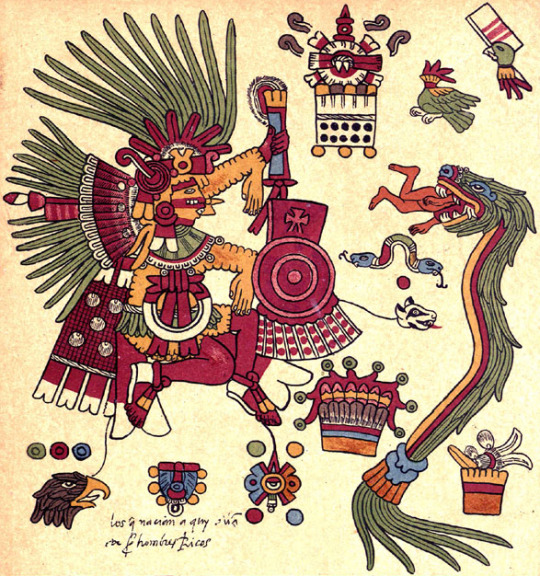
Xipe Totec, pictured in the Codex Borbonicus.
(Source: Codex Borbonicus, Public domain, via Wikimedia Commons)
“At his festival the Mexicans killed all the prisoners they had taken in war, men, women, and children. The number of the victims was very great. A Spanish historian of the sixteenth century [Diego Duran, pp. 147-8] estimated that in Mexico more people used to be sacrificed on the altar than died a natural death. All who were sacrificed to Xipe, ‘the Flayed God,’ were themselves flayed, and men who had made a special vow to the god put on the skins of the human victims and went about the city in that guise for twenty days, being everywhere welcomed and revered as living images of the deity. Forty days before the festival, according to the historian Duran, they chose a man to personate the god, clothed him in all the insignia of the divinity, and led him about in public, doing him as much reverence all these days as if he had really been what he pretended to be. Moreover, every parish of the capital did the same; each of them had its own temple and appointed its own human representative of the deity, who received the homage and worship of the parishioners for the forty days.
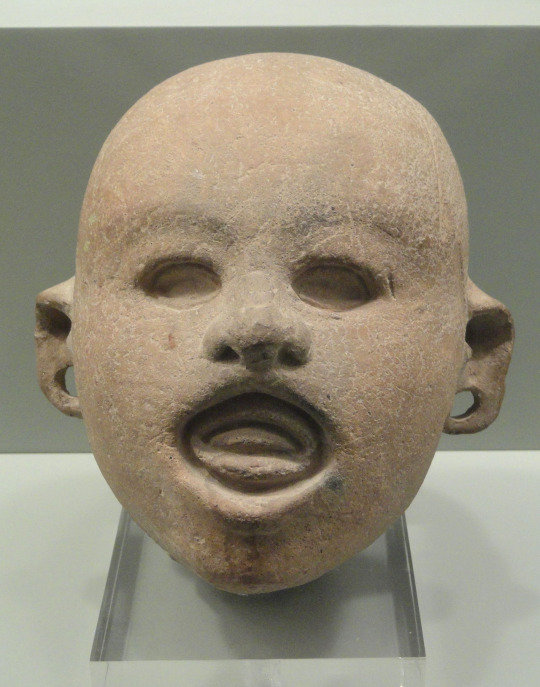
Earthenware representation of Xipe Totec wearing a mask of flayed human skin (Aztec, c. 1428-1521 CE; found in Mexico, now in the Gardiner Museum, Toronto).
(Source: Daderot, CC0, via Wikimedia Commons)
“On the day of the festival these mortal gods and all the other prisoners, with the exception of a few who were reserved for a different death, were killed in the usual way. The scene of the slaughter was the platform on the summit of the god Huitzilopochtli's temple. Some of the poor wretches fainted when they came to the foot of the steps and had to be dragged up the long staircase by the hair of their heads. Arrived at the summit they were slaughtered one by one on the sacrificial stone by the high priest, who cut open their breasts, tore out their hearts, and held them up to the sun, in order to feed the great luminary with these bleeding relics. Then the bodies were sent rolling down the staircase, clattering and turning over and over like gourds as they bumped from step to step till they reached the bottom. There they were received by other priests, or rather human butchers, who with a dexterity acquired by practice slit the back of each body from the nape of the neck to the heels and peeled off the whole skin in a single piece as neatly as if it had been a sheepskin. The skinless body was then fetched away by its owner, that is, by the man who had captured the prisoner in war. He took it home with him, carved it, sent one of the thighs to the king, and other joints to friends, or invited them to come and feast on the carcase in his house.
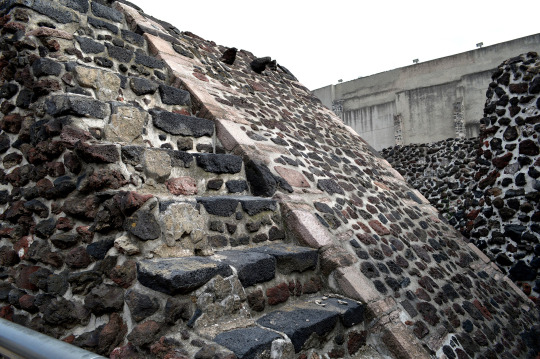
Ruins of the Templo Mayor in Mexico City.
(Source: AlejandroLinaresGarcia, CC BY-SA 3.0, via Wikimedia Commons)
“The skins of the human victims were also a perquisite of their captors, and were lent or hired out by them to men who had made a vow of going about clad in the hides for twenty days. Such men clothed in the reeking skins of the butchered prisoners were called Xixipeme or Tototectin after the god Xipe or Totec, whose living image they were esteemed and whose costume they wore. Among the devotees who bound themselves to this pious exercise were persons who suffered from loathsome skin diseases, such as smallpox, abscesses, and the itch; and among them there was a fair sprinkling of debauchees, who had drunk themselves nearly blind and hoped to recover the use of their precious eyes by parading for a month in this curious mantle. Thus arrayed, they went from house to house throughout the city, entering everywhere and asking alms for the love of God. On entering a house each of these reverend palmers was made to sit on a heap of leaves; festoons of maize and wreaths of flowers were placed round his body; and he was given wine to drink and cakes to eat. And when a mother saw one of these filthy but sanctified ruffians passing along the street, she would run to him with her infant and put it in his arms that he might bless it, which he did with unction, receiving an alms from the happy mother in return. The earnings of these begging-friars on their rounds were sometimes considerable, for the rich people rewarded them handsomely. Whatever they were, the collectors paid them in to the owners of the skins, who thus made a profit by hiring out these valuable articles of property. Every night the wearers of the skins deposited them in the temple and fetched them again next morning when they set out on their rounds.
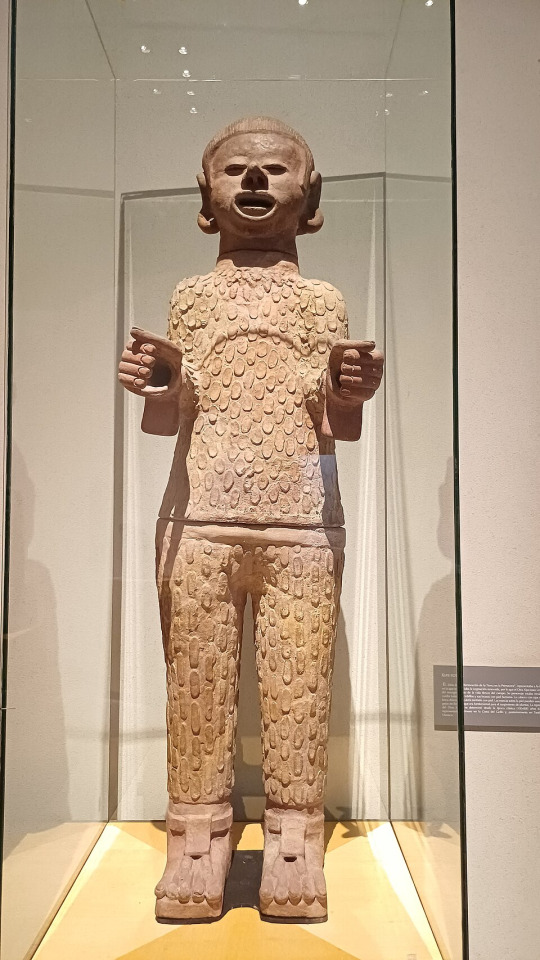
Statue of Xipe Totec clad in flayed human skin (National Museum of Anthropology, Mexico).
(Source: José Luiz Bernardes Ribeiro, CC BY-SA 4.0, via Wikimedia Commons)
“At the end of the twenty days the skins were dry, hard, shrivelled and shrunken, and they smelt so villainously that people held their noses when they met the holy beggars arrayed in their fetid mantles. The time being come to rid themselves of these encumbrances, the devotees walked in solemn procession, wearing the rotten skins and stinking like dead dogs, to the temple called Yopico, where they stripped themselves of the hides and plunged them into a tub or vat, after which they washed and scrubbed themselves thoroughly, while their friends smacked their bare bodies loudly with wet hands in order to squeeze out the human grease with which they were saturated. Finally, the skins were solemnly buried, as holy relics, in a vault of the temple. The burial service was accompanied by chanting and attended by the whole people; and when it was over, one of the high dignitaries preached a sermon to the assembled congregation, in which he dwelt with pathetic [1] eloquence on the meanness and misery of human existence and exhorted his hearers to lead a sober and quiet life, to cultivate the virtues of reverence, modesty, humility and obedience, to be kind and charitable to the poor and to strangers; he warned them against the sins of robbery, fornication, adultery, and covetousness; and kindling with the glow of his oratory, he passionately admonished, entreated, and implored all who heard him to choose the good and shun the evil, drawing a dreadful picture of the ills that would overtake the wicked here and hereafter, while he painted in alluring colours the bliss in store for the righteous and the rewards they might expect to receive at the hands of the deity in the life to come.
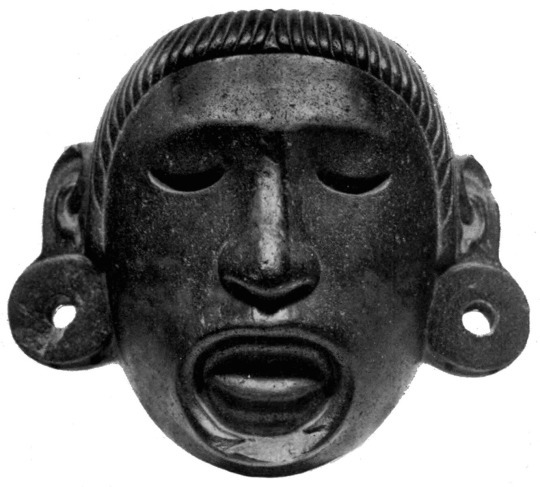
Stone mask of Xipe Totec, included as an illustration in Mexican Archæology (G. P. Putnam's Sons, 1914), by T. A. Joyce (see plate IV).
(Source: T. A. Joyce, Public domain, via Wikimedia Commons)
“While most of the men who masqueraded in the skins of the human victims appear to have personated the Flayed God Xipe, whose name they bore in the form Xixipeme, others assumed the ornaments and bore the names of other Mexican deities, such as Huitzilopochtli and Quetzalcoatl; the ceremony of investing them with the skins and the insignia of divinity was called netcotoquiliztli, which means ‘to think themselves gods.’ Amongst the gods thus personated was Totec. His human representative wore, over the skin of the flayed man, all the splendid trappings of the deity. On his head was placed a curious crown decorated with rich feathers. A golden crescent dangled from his nose, golden earrings from his ears, and a necklace of hammered gold encircled his neck. His feet were shod in red shoes decorated with quail's feathers; his loins were begirt with a petticoat of gorgeous plumage; and on his back three small paper flags fluttered and rustled in the wind. In his left hand he carried a golden shield and in his right a rattle, which he shook and rattled as he walked with a majestic dancing step. Seats were always prepared for this human god; and when he sat down, they offered him a paste made of uncooked maize-flour. Also they presented to him little bunches of cobs of maize chosen from the seed-corn; and he received as offerings the first fruits and the first flowers of the season.”
—J. G. Frazer, The Scapegoat (The Golden Bough, vol. IX, 1913, p. 296-300)
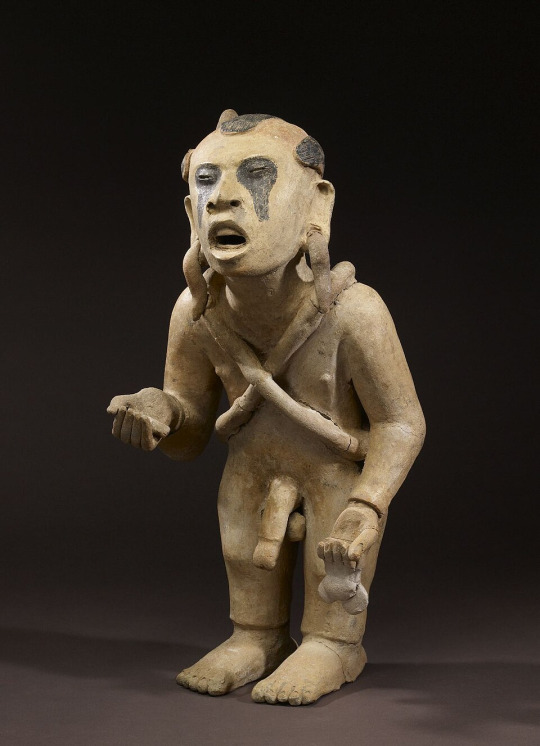
Earthenware statue of one of Xipe Totec's impersonators, executed by an unknown artist in the Remojadas style (c. 600-900 CE; found in Veracruz, today in the Walters Art Museum at Baltimore, MD, USA).
(Source: Walters Art Museum, Public domain, via Wikimedia Commons)
[1] Frazer, whose prose was most influenced by 18th century writers like Joseph Addison and Edward Gibbon, [2] here uses the word “pathetic” in its more archaic sense: he means that the eloquence of the dignitary was emotionally affecting, not that it was sad or pitiful.
[2] Robert Ackerman, J. G. Frazer: His Life & Work (Cambridge, 1987), p. 23.
#jg frazer#the golden bough#the golden bough vol ix#xipe totec#aztecs#aztec mythology#aztec religion#gods#human sacrifice#religious practices#flaying#ancient mexico
3 notes
·
View notes
Text
This also applies to religious practice, too.✌️
Fine. Here you have it. The one true rule of witchcraft:
Stop bitching about other people's practices and focus on your own
#witchcraft#spellcraft#personal practice#paganism#pagan#heathen#heathenry#lokean#religion#religious practices#opinion
1K notes
·
View notes
Text
Buddhist Rituals and religious practices
Rituals are a form of language expressing several dimensions of the human condition, ranging from their relationships with others to their spiritual lives. As an essential part of human lives, such rituals have had a significant presence in the practice of Buddhism, known as Buddhist rituals. Buddhist Rituals have been performed throughout the ages to show one's devotion and reverence towards the Buddha, the enlightened one, in the form of different ceremonies, meditation, festivals, and retreats. Read more at:
Buddhist Rituals and Worship | Burmese Art


1 note
·
View note
Text
The Hidden Stories Behind Kotgarh’s Devta Marich Ji and His Ancient Rituals
#Ancient Customs#cultural heritage#Devta Marich Ji#divine legends of India#Himachal culture#Himachal Pradesh#Hindu deities#hindu mythology#Historical Traditions#Kotgarh#Kotgarh temples#Lost Traditions#Marich Ji#mysterious temples of India#Religious Practices#sacred cremation practices#Sacred Dance#spiritual mysteries of India#spiritual protection#Spiritual Rituals#temple rituals#unexplored Himachal#unique rituals
0 notes
Text
Chingay in JB, a feast for the senses
Johor Bahru’s Chingay is quite a spectacle to behold. Where Singapore’s modern take on the southern Chinese tradition of youshen, or procession of dieties, is contained and choreographed, the JB parade is an unabashed expression of faith, unity, and community spirit. The JB parade, which has been around for some 150 years. Except for 1942, when the war came, JB’s Chingay has been held annually…
#Chingay#Cultural Events#Johor#Johor Bahru#Malaysia#Photographs#Photography#Processions#Religious Festivals#Religious Practices#Religious Procession#Street Parade#Youshen
0 notes